Steven van de Par
Room impulse response prototyping using receiver distance estimations for high quality room equalisation algorithms
Sep 16, 2024



Abstract:Room equalisation aims to increase the quality of loudspeaker reproduction in reverberant environments, compensating for colouration caused by imperfect room reflections and frequency dependant loudspeaker directivity. A common technique in the field of room equalisation, is to invert a prototype Room Impulse Response (RIR). Rather than inverting a single RIR at the listening position, a prototype response is composed of several responses distributed around the listening area. This paper proposes a method of impulse response prototyping, using estimated receiver positions, to form a weighted average prototype response. A method of receiver distance estimation is described, supporting the implementation of the prototype RIR. The proposed prototyping method is compared to other methods by measuring their post equalisation spectral deviation at several positions in a simulated room.
Combined assessment of auditory distance perception and externalization
Aug 26, 2024



Abstract:This study investigates frontal auditory distance perception (ADP) and externalization in virtual audio-visual environments, considering effects of headphone rendering method, room size, reverberation, and visual representation of the room. Either head-related impulse responses from an artificial head or a spherical head model were used for diotic (monophonic) and binaural auralizations with and without real-time head tracking. The visuals were presented through a head-mounted display. Two differently sized rooms as well as an infinitely extending space (echoic and anechoic) were used in which an invisible frontal virtual sound source was located. Additionally, the effect of a freely movable loudspeaker for visually indicating perceived distances was investigated. Both ADP and externalization were significantly affected by room size, but otherwise the two perceptual quantities differed in their outcomes. Room visibility significantly affected ADP, leading to considerable overestimations and more variability in the absence of a visual environment, although externalization was not affected. The movable loudspeaker improved distance estimation significantly, however, did not affect externalization. For reverberation, a (non-significant) trend of improved ADP was observed, however, externalization was significantly improved. Different headphone renderings did not significantly affect ADP or externalization, although a clear trend was observed for externalization.
The effect of self-motion and room familiarity on sound source localization in virtual environments
Aug 25, 2024Abstract:This paper investigates the influence of lateral horizontal self-motion of participants during signal presentation on distance and azimuth perception for frontal sound sources in a rectangular room. Additionally, the effect of deviating room acoustics for a single sound presentation embedded in a sequence of presentations using a baseline room acoustics for familiarization is analyzed. For this purpose, two experiments were conducted using audiovisual virtual reality technology with dynamic head-tracking and real-time auralization over headphones combined with visual rendering of the room using a head-mounted display. Results show an improved distance perception accuracy when participants moved laterally during signal presentation instead of staying at a fixed position, with only head movements allowed. Adaptation to the room acoustics also improves distance perception accuracy. Azimuth perception seems to be independent of lateral movements during signal presentation and could even be negatively influenced by the familiarity of the used room acoustics.
Reverberant sound field equalisation for an enhanced stereo playback experience
Nov 01, 2023Abstract:The topic of room equalisation has been at the forefront of research and product development for many years, with the aim of increasing the playback quality of loudspeakers in reverberant rooms. Traditional room equalisation systems comprise of a number of filters that when applied to the primary loudspeakers, additional room colouration is compensated for. This publication introduces a novel equalisation technique where gammatone filter band energy is added to the reverberant sound field via two surround loudspeakers, leaving the direct sound from the primary loudspeakers unaltered, but the sum of direct and reverberant energy is equalised at the listening position. Unlike traditional systems, this method allows the target function of the direct sound to differ from the reverberant sound field. The proposed method is motivated by the different roles direct and reverberant sound components play in humans perception of sound. Along with introducing the proposed method, results from a subjective listening test are presented, demonstrating the preference towards the proposed technique when compared to a traditional room equalisation technique and stereo playback.
Computationally-efficient and perceptually-motivated rendering of diffuse reflections in room acoustics simulation
Jun 29, 2023Abstract:Geometrical acoustics is well suited for simulating room reverberation in interactive real-time applications. While the image source model (ISM) is exceptionally fast, the restriction to specular reflections impacts its perceptual plausibility. To account for diffuse late reverberation, hybrid approaches have been proposed, e.g., using a feedback delay network (FDN) in combination with the ISM. Here, a computationally-efficient, digital-filter approach is suggested to account for effects of non-specular reflections in the ISM and to couple scattered sound into a diffuse reverberation model using a spatially rendered FDN. Depending on the scattering coefficient of a room boundary, energy of each image source is split into a specular and a scattered part which is added to the diffuse sound field. Temporal effects as observed for an infinite ideal diffuse (Lambertian) reflector are simulated using cascaded all-pass filters. Effects of scattering and multiple (inter-) reflections caused by larger geometric disturbances at walls and by objects in the room are accounted for in a highly simplified manner. Using a single parameter to quantify deviations from an empty shoebox room, each reflection is temporally smeared using cascaded all-pass filters. The proposed method was perceptually evaluated against dummy head recordings of real rooms.
On the relevance of acoustic measurements for creating realistic virtual acoustic environments
Jun 29, 2023Abstract:Geometrical approaches for room acoustics simulation have the advantage of requiring limited computational resources while still achieving a high perceptual plausibility. A common approach is using the image source model for direct and early reflections in connection with further simplified models such as a feedback delay network for the diffuse reverberant tail. When recreating real spaces as virtual acoustic environments using room acoustics simulation, the perceptual relevance of individual parameters in the simulation is unclear. Here we investigate the importance of underlying acoustical measurements and technical evaluation methods to obtain high-quality room acoustics simulations in agreement with dummy-head recordings of a real space. We focus on the role of source directivity. The effect of including measured, modelled, and omnidirectional source directivity in room acoustics simulations was assessed in comparison to the measured reference. Technical evaluation strategies to verify and improve the accuracy of various elements in the simulation processing chain from source, the room properties, to the receiver are presented. Perceptual results from an ABX listening experiment with random speech tokens are shown and compared with technical measures for a ranking of simulation approaches.
Evaluation of Virtual Acoustic Environments with Different Acoustic Level of Detail
Jun 29, 2023Abstract:Virtual acoustic environments enable the creation and simulation of realistic and ecologically valid daily-life situations with applications in hearing research and audiology. Hereby, reverberant indoor environments play an important role. For real-time applications, simplifications in the room acoustics simulation are required, however, it remains unclear what acoustic level of detail (ALOD) is necessary to capture all perceptually relevant effects. This study investigates the effect of varying ALOD in the simulation of three different real environments, a living room with a coupled kitchen, a pub, and an underground station. ALOD was varied by generating different numbers of image sources for early reflections, or by excluding geometrical room details specific for each environment. The simulations were perceptually evaluated using headphones in comparison to binaural room impulse responses measured with a dummy head in the corresponding real environments. The study assessed the perceived overall difference for a pink pulse, and a speech token. Furthermore, plausibility and externalization were evaluated. The results show that a strong reduction in ALOD is possible while obtaining similar plausibility and externalization as with dummy head recordings. The number and accuracy of early reflections appear less relevant, provided diffuse late reverberation is appropriately accounted for.
Computationally efficient spatial rendering of late reverberation in virtual acoustic environments
Jun 30, 2021
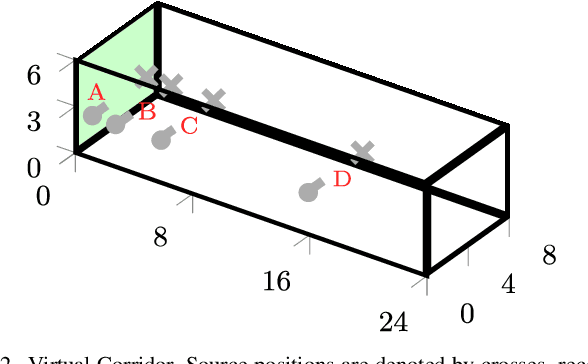
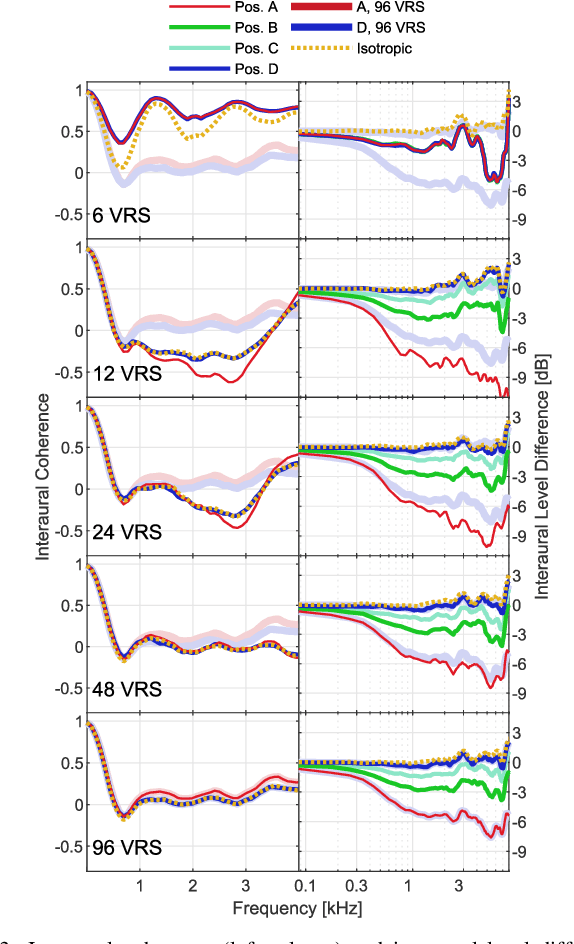
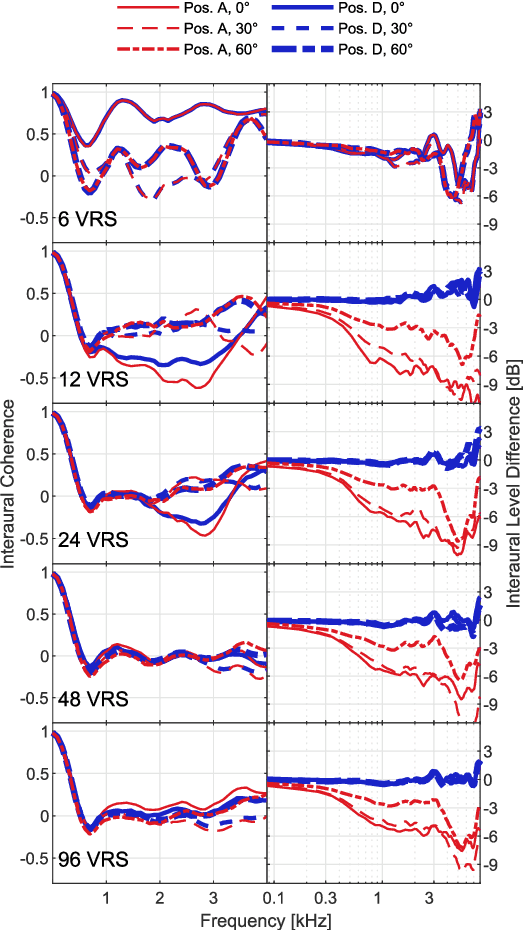
Abstract:For 6-DOF (degrees of freedom) interactive virtual acoustic environments (VAEs), the spatial rendering of diffuse late reverberation in addition to early (specular) reflections is important. In the interest of computational efficiency, the acoustic simulation of the late reverberation can be simplified by using a limited number of spatially distributed virtual reverb sources (VRS) each radiating incoherent signals. A sufficient number of VRS is needed to approximate spatially anisotropic late reverberation, e.g., in a room with inhomogeneous distribution of absorption at the boundaries. Here, a highly efficient and perceptually plausible method to generate and spatially render late reverberation is suggested, extending the room acoustics simulator RAZR [Wendt et al., J. Audio Eng. Soc., 62, 11 (2014)]. The room dimensions and frequency-dependent absorption coefficients at the wall boundaries are used to determine the parameters of a physically-based feedback delay network (FDN) to generate the incoherent VRS signals. The VRS are spatially distributed around the listener with weighting factors representing the spatially subsampled distribution of absorption coefficients on the wall boundaries. The minimum number of VRS required to be perceptually distinguishable from the maximum (reference) number of 96 VRS was assessed in a listening test conducted with a spherical loudspeaker array within an anechoic room. For the resulting low numbers of VRS suited for spatial rendering, optimal physically-based parameter choices for the FDN are discussed.
Spatial resolution of late reverberation in virtual acoustic environments
Jun 30, 2021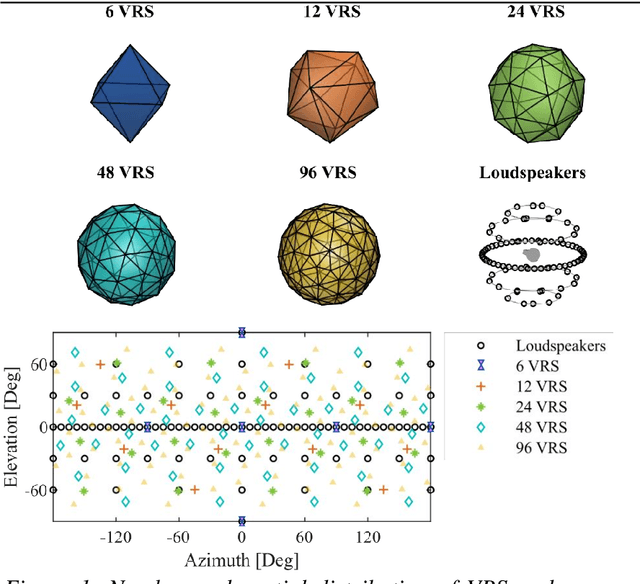
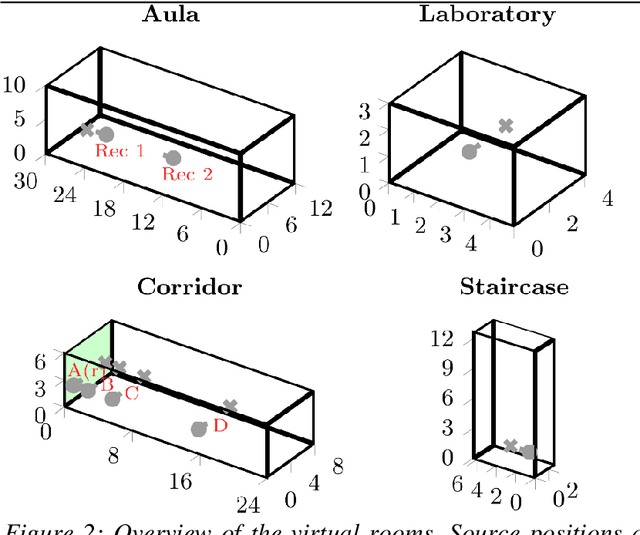


Abstract:Late reverberation involves the superposition of many sound reflections resulting in a diffuse sound field. Since the spatially resolved perception of individual diffuse reflections is impossible, simplifications can potentially be made for modelling late reverberation in room acoustics simulations with reduced spatial resolution. Such simplifications are desired for interactive, real-time virtual acoustic environments with applications in hearing research and for the evaluation of hearing supportive devices. In this context, the number and spatial arrangement of loudspeakers used for playback additionally affect spatial resolution. The current study assessed the minimum number of spatially evenly distributed virtual late reverberation sources required to perceptually approximate spatially highly resolved isotropic and anisotropic late reverberation and to technically approximate a spherically isotropic diffuse sound field. The spatial resolution of the rendering was systematically reduced by using subsets of the loudspeakers of an 86-channel spherical loudspeaker array in an anechoic chamber. It was tested whether listeners can distinguish lower spatial resolutions for the rendering of late reverberation from the highest achievable spatial resolution in different simulated rooms. Rendering of early reflections was kept fixed. The coherence of the sound field across a pair of microphones at ear and behind-the-ear hearing device distance was assessed to separate the effects of number of virtual sources and loudspeaker array geometry. Results show that between 12 and 24 reverberation sources are required.
Localization based on enhanced low frequency interaural level difference
Jun 17, 2021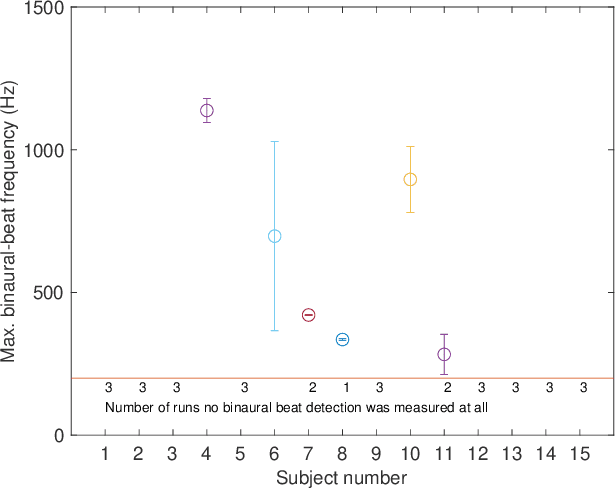
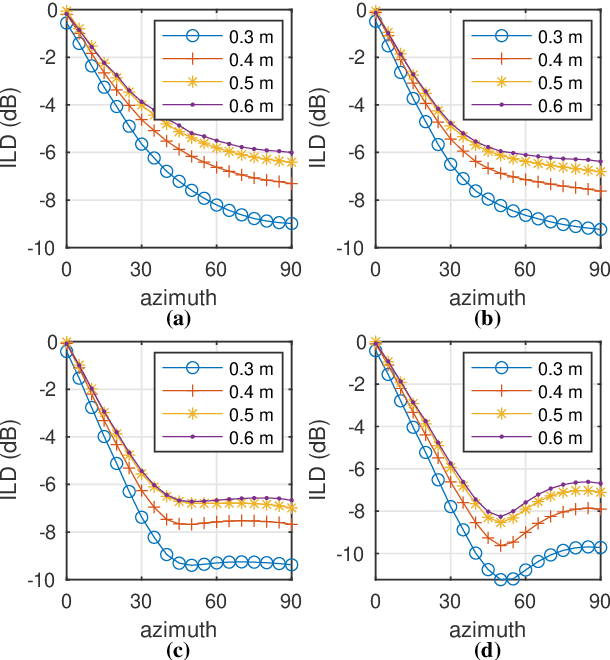
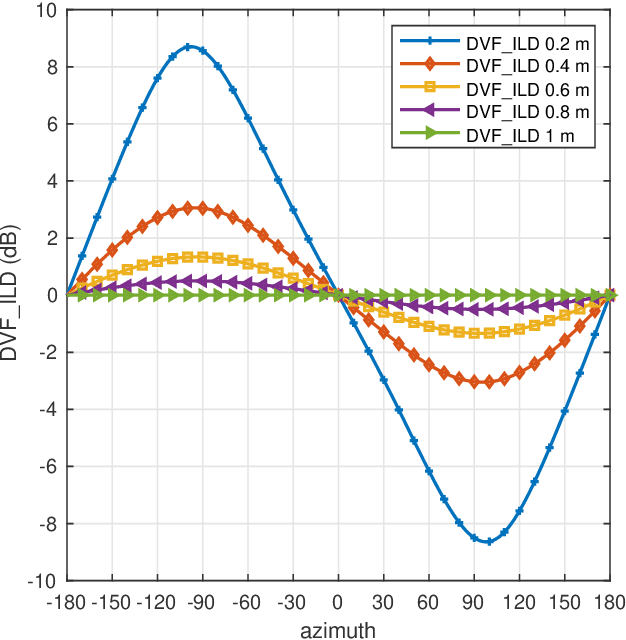
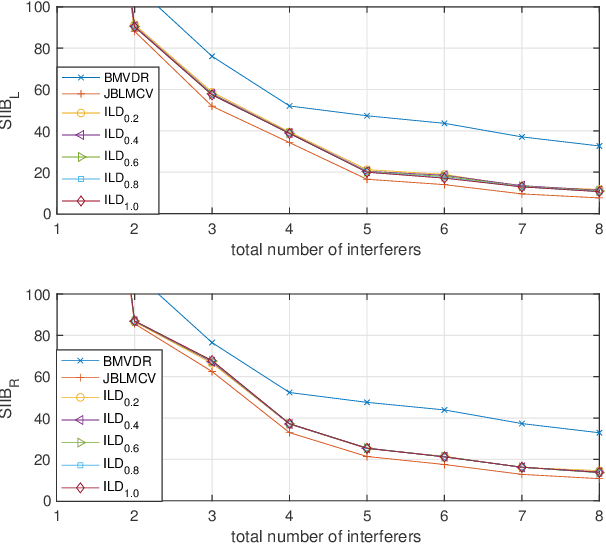
Abstract:The processing of low-frequency interaural time differences is found to be problematic among hearing-impaired people. The current generation of beamformers does not consider this deficiency. In an attempt to tackle this issue, we propose to replace the inaudible interaural time differences in the low-frequency region with the interaural level differences. In addition, a beamformer is introduced and analyzed, which enhances the low-frequency interaural level differences of the sound sources using a near-field transformation. The proposed beamforming problem is relaxed to a convex problem using semi-definite relaxation. The instrumental analysis suggests that the low-frequency interaural level differences are enhanced without hindering the provided intelligibility. A psychoacoustic localization test is done using a listening experiment, which suggests that the replacement of time differences into level differences improves the localization performance of normal-hearing listeners for an anechoic scene but not for a reverberant scene.
 Add to Chrome
Add to Chrome Add to Firefox
Add to Firefox Add to Edge
Add to Edge